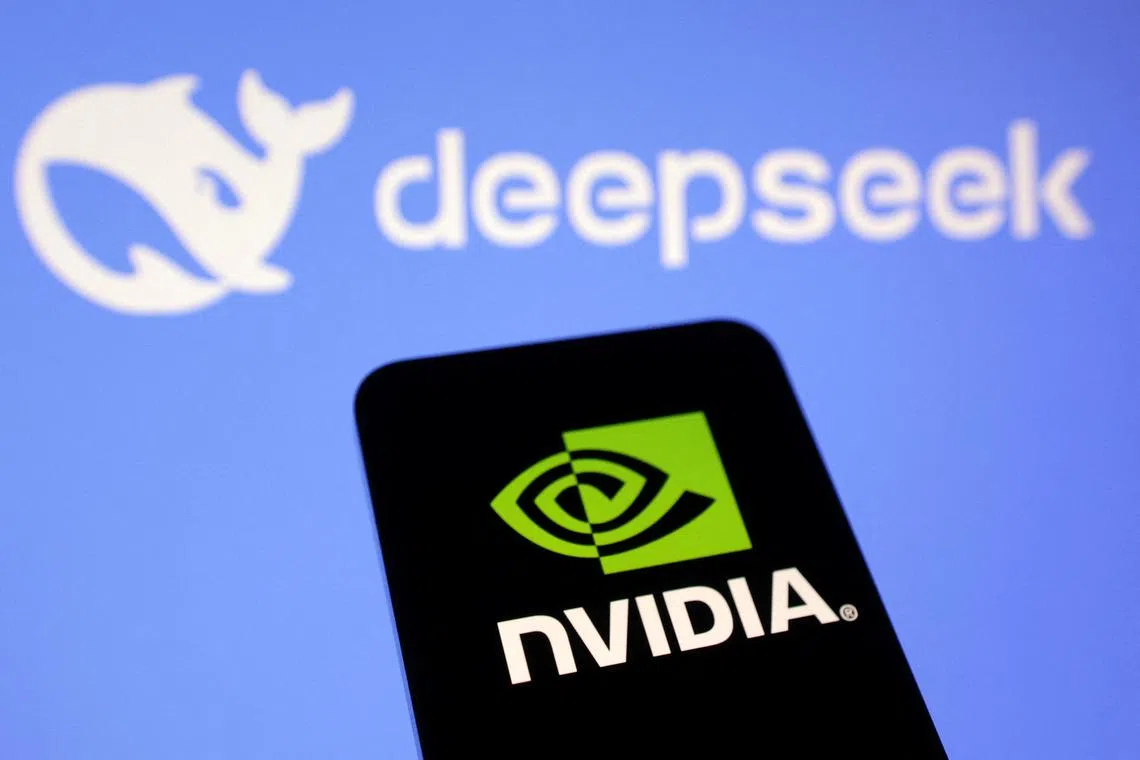DeepSeek’s AI model tests limits of US curbs on Nvidia chips
Sign up now: Get ST's newsletters delivered to your inbox

DeepSeek says it used less-advanced Nvidia H800 chips to build a model that appears on a par with the best offerings from OpenAI.
PHOTO: REUTERS
Follow topic:
Washington – Powerful artificial intelligence (AI) software from Chinese start-up DeepSeek
The company’s recently released R1 model, which it claims to have developed at a fraction of the cost borne by rival AI companies, sent tech stocks into a tailspin on Jan 27 as investors questioned the need to spend billions on advanced hardware. It has also sparked a debate in Washington about the best strategy to prevent China from developing cutting-edge AI, which US policymakers see as a national security risk.
The US imposed sweeping controls on the sale of the most advanced Nvidia chips to China in October 2022, and has ratcheted up the measures each year since. But Nvidia has responded by designing new semiconductors for the Chinese market – including those DeepSeek likely used to build R1.
DeepSeek says it used less-advanced Nvidia H800 chips, which the US government allowed to be shipped to China until October 2023, to build a model that appears on a par with the best offerings from OpenAI. Nvidia on Jan 27 called the work an “excellent AI advance” that illustrates how companies can leverage “widely available models and compute that is fully export control compliant”.
“Export laws limited the available resources, so Chinese engineers needed to get creative – and they did,” said Mr Pat Gelsinger, Intel’s former chief executive officer. “Engineering is about constraints.”
Nvidia’s chips have emerged as the most sought-after commodity in the AI world, making them a geopolitical flash point between the world’s two largest economies. China remains a crucial market for the chipmaker, which created an even less-advanced model dubbed H20 for the Asian nation.
On Jan 27, US lawmakers called on the new administration of President Donald Trump to impose stricter export curbs to keep China from achieving further gains in AI.
The US cannot allow Chinese models such as DeepSeek “to risk our national security and leverage our technology to advance their AI ambitions”, Representative John Moolenaar, a Michigan Republican who co-chairs a select committee on competition with China, said in a statement. “We must work to swiftly place stronger export controls on technologies critical to DeepSeek’s AI infrastructure.”
DeepSeek’s breakthrough, released the day Mr Trump took office, presents a challenge to the new president. His team must decide not just whether to keep in place new global chip restrictions imposed at the end of President Joe Biden’s term, but also whether to squeeze China further – possibly by expanding controls to cover even more Nvidia chips, such as the H20.
Mr Trump said on Jan 27 that DeepSeek “should be a wake-up call for our industries that we need to be laser-focused on competing to win”. He also lauded its R1 model as a “positive development” that could allow for less expensive AI advancements across the board. DeepSeek’s research is publicly accessible, meaning that US companies could take advantage of its technological innovations – while also benefiting from significantly greater computational power.
For his part, Nvidia CEO Jensen Huang has said he anticipates Mr Trump will bring less semiconductor regulation, in a boon for the industry. Unlike many of his tech peers, Mr Huang skipped the inaugural festivities in Washington to visit China and Taiwan, as is usual for him during the Chinese New Year holiday period.
Over the past several years, US officials have tightened restrictions on exports of a wide range of sensitive technology to China, including high-bandwidth memory chips and sophisticated chip-making machinery. Those measures “are working but they’re not perfect”, said Mr Donald Pearce, a former Commerce Department official now with Torres Trade Advisory.
“The earlier the choke point technology is identified, and the quicker a government can implement effective controls in a multilateral fashion with its allies and partners, the easier this is,” said Mr Pearce, a retired special agent with the department’s Bureau of Industry and Security, which oversees semiconductor export controls.
To create its model, DeepSeek was able to get past barriers on what is known as interconnect speed – the capability that Nvidia downgraded on the chips it designed for China after the initial round of US controls, according to Mr Greg Allen, director of the Wadhwani AI Centre at the Centre for Strategic and International Studies.
The fact that DeepSeek managed to build R1 illustrates “lagging impact of the failure of the October 2022 export controls”, Mr Allen said. But very soon, he said, “we will be living through the success of the October 2023 export controls.”
Scaling and continuing to develop the model requires mass computational capability, Mr Allen said – and as of October 2023, DeepSeek can no longer buy the Nvidia chips that powered its training process.
“Money has never been the problem for us,” DeepSeek CEO Liang Wenfeng said in 2024. “Bans on shipments of advanced chips are the problem.” BLOOMBERG

